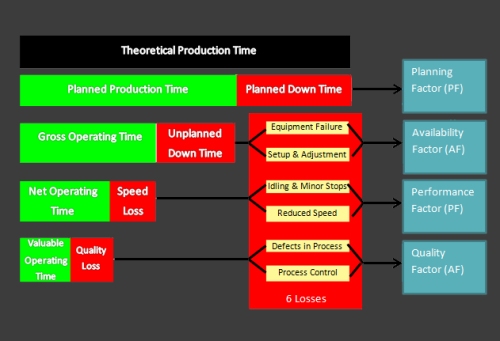OEE – Overall Equipment Effectiveness
by theleanthinker
OEE – Overall Equipment Effectiveness
As my previous blog post was about TPM, I feel that a good place to start for today’s post would be OEE. OEE is one way to measure the “usefulness” of a machine or operation, and is one of the eight pillars of TPM. It is used as a key performance indicator in many Lean organisations, and can be used as an indicator of process improvement. OEE helps quantify the machine in terms of its capacity, against the available time it is scheduled to be running.
The object of calculating and monitoring OEE is to maximise the efficiency, by eliminating waste and manufacturing losses. The manufacturing losses are:
- Man
- Machine
- Method
- Material
On top of these 4 manufacturing losses, there are also 6 machine losses (yes Lean has a lot of ‘3 this’, ‘4 of that’, ‘7 of these’):
- Downtime Losses
- Equipment failure – repair
- Unplanned adjustment & setup
- Speed Losses
- Idling & minor stops
- Reduced speed
- Quality Losses
- Process out of control (machine)
- Poor process control (method)
OEE is calculated with the time expected to run, therefore planned stoppages or downtime does not negatively affect the OEE.
So how do we calculate OEE?
A breakdown of the OEE components can be seen in the diagram below:
OEE = AF x PF x QF
Total Productivity = OEE x PF
AF = (time available for production – downtime) / time available for production
PF = theoretical time to produce output / actual operating time
QF = (total output – defects) / total output
I apologise now for the poor formatting of the above formulas, but it’s the best I can do on WordPress I’m afraid.
It has been said that if you can measure it, then you can manage it, be that true or not, OEE certainly provides the framework to measure the efficiency of processes, and therefore understand if improvements are being made. Along with this there are many benefits to OEE:
- Helps improve manufacturing productivity
- Helps improve production quality
- Improves machine utilisation
- Communicates production status
- Improves accuracy and efficiency
- Reduces unproductive labour
- Improves scheduling efficiency

Excellent Summary of OEE. OEE is a great tool for measuring progress because it takes much of the subjectivity out of the old fashioned production efficiency measurements.
Chris Paulsen
A good article from Bob Duckles explains what to do with OEE, once you have calculated it from the information above.
OEE Link
OEE is most certainly a powerful tool in the right hands working under strong leadership. OEE should not be used as a stand alone metric where it is possible to compromise other business goals and objectives to improve “the number”.
For example, availability losses due to set up time can easily be minimized by running more parts or throughput can be improved by adding more people. Overall this is a nice summary, however, it is imperative to understand what OEE is NOT as well.
OEE measures Effectiveness not Efficiency. I think this is one of the points that many people miss.
Great article about Overall Equipment Effectiveness!! Downtime Tracking and OEE are the factors on which one must focus. Thrive’s downtime tracking software helps in OEE Calculation, downtime tracking and increasing the ROI, professionals are recommending it.